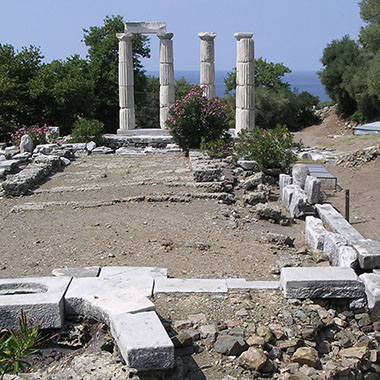|
|
 |
| My Favourite Planet > English > Europe > Greece > Northern Aegean > Samothraki > gallery |
 |
| Samothraki, Greece |
Samothraki gallery |
 |
 |
20 of 46 |
 |
 |
|
 |

Sanctuary of the Great Gods. The Hieron (325-150 BC). |
| |
The Hieron was an imposing, richly decorated hall, around 13 metres wide and 40 metres long, in the southwest section of the Sanctuary of the Great Gods. The building of Thasian marble stood on a foundation of rough limestone blocks.

Unusually, it was built on an axis from the northwest to the southeast, with a wide Doric porch at the front (northwest) and a rounded (apsidal) rear.

As with many of the structures in Samothraki, its exact function and the date of construction remain unknown. It is thought that it was begun around 325 BC and then renovated or altered several times over the proceeeding centuries. Other scholars believe it was built in the early third century BC. A final major renovation may have been made as late as 200 AD, during the Roman Imperial period. It was probably destroyed by an enormous earthquake in the mid sixth century AD.

The building is named "the Hieron" due to an inscription dicovered by archaeologists which forbade entrance of those uninitiated into the cult "to the Hieron" [1]. It may have been where the most sacred rite of the mysteries was performed.

The main hall was lined by marble benches along each of the long walls. The decoration of the building included coffered ceilings and sculptures inside and out. Many of the sculptures are now in the Ephesos Museum, Vienna. |
|
photo:
© David John |
|
| |
| Samothraki |
Notes, references and links |
 |
|

1. The naming of "the Hieron"

The inscription mentioning the Hieron was discovered in July 1951, 4 metres west of the pronaos (entrance to the building), by archaeologists of New York University, supervised by Phyllis Williams Lehmann (1912-2004). It has been dated to the first or second century BC.

The inscription, ordering the uninitiated (amyetoi) not to enter the hieron, is of three lines in Hellenistic lettering on a fragment of Thasian marble, which formed the top left corner of a stele.

ἀμύητον
μὴ εἰσιέναι
εἰς τὸ ἱερόν

Archaeological Museum of Samothrace.
Inv. No. 51.501. Inscription SEG XII 395.
Height 17 cm, width 38 cm, thickness 9 cm;
height of lettering 3.2 cm (line 1), 2.8 cm (lines 2-3).

The naming of the building as "the Hieron" is controversial, as the inscription was found some distance from it, and the word hieron (ἱερόν) usually meant a sanctuary as a whole rather than a temple or other structure within it. Earlier, Austrian archaeologists had named it the "New Temple". In 1953 Karl Lehmann wrote:

"If the text of the lex sacra as preserved is complete - the badly destroyed surface at the right does not allow this conclusion to be drawn with absolute certainty - the "New Temple", used for the most sacred rite of the mysteries, was specifically called τὸ ἱερόν. In the Samothracian decree in honor of Lysimachus (between 288-7 and 280-1), it is reported that the plunderers of the sanctuary entered the Hieron by night for unlawful and impious deeds, after they had tried to plunder the votive gifts of the kings and other Greeks and after they had attempted to set the temenos of the Gods afire." [I.G., XII, 8, 150, lines 4 ff.]

Karl Lehmann, 1953, Samothrace: Sixth preliminary report. Hesperia 22, pages 1-24 (plates 1-9). American School of Classical Studies at Athens, 1953.

See also:

Nora Mitkova Dimitrova, Theoroi and Initiates in Samothrace: The Epigraphical Evidence. Hesperia Supplement 37, pages 239-240. American School of Classical Studies at Athens, 2008.

O. Palagia, Y. Maniatis, E. Dotsika and D. Kavoussanaki, New investigations on the pedimental sculptures of the "Hieron" of Samothrace: A preliminary report. BCH Supplément 51, pages 113-132. École française d’Athènes, 2009. |
|
|
Photos, maps and articles: © David John,
except where otherwise specified.
All photos and articles are copyright protected.
Images and materials by other authors
have been attributed where applicable.
Please do not use these photos or articles without permission.
If you are interested in using any of the photos for your website,
project or publication, please get in contact.
Higher resolution versions are available on request.
Some of the information and photos in this guide to Samothraki
originally appeared in 2004 on davidjohnberlin.de.
My Favourite Planet makes great efforts to provide comprehensive and accurate information across this website. However, we can take no responsibility for inaccuracies or changes made by providers of services mentioned on these pages. |
|
| |
 |
Visit the My Favourite Planet Group on Facebook.

Join the group, write a message or comment,
post photos and videos, start a discussion... |
|
|
 |
|
|
| |
| |
 |
| |
 |
| |
 |
| |
 |
| |

George Alvanos

rooms
in Kavala's historic Panagia District

Anthemiou 35,
Kavala, Greece

kavalarooms.gr
 |
| |
|